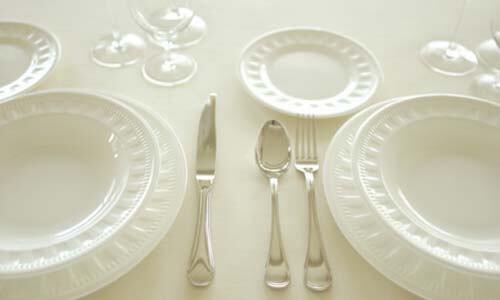Care of Dinnerware
Table Setting Guide
"Proper dinnerware care" depends on a number of factors, including the type of glaze, the use of metals in the design, whether the dinnerware is dishwasher-safe or requires hand care, and the methods of storage.
Glazes
The ornamentation of dinnerware lies underglaze or overglaze, and sometimes both methods are used.
Underglaze ornamentation has a smooth surface and the glaze is not subject to corrosive food acids or scratches made by normal use of a dinner knife. This decorative technique is safe in a microwave oven and a dishwasher, when stated by the manufacturer.
Overglaze ornamentation is vulnerable to corrosive food acids, and subject to fading in the drying cycle of a dishwasher. Dinnerware with overglaze ornamentation should be rinsed as soon as possible after use. Moreover, the ornamentation is unprotected, and is prone to scratches made from sharp objects, so during cleanup it is never scraped with the blade of a dinner knife. Instead, food debris should be wiped with a paper towel, and stubborn spots are soaked and removed with a plastic scouring pad.
Care of Precious Metals
If you're not sure whether to machine-wash or hand-wash, experiment with a small plate, such as a saucer. Place the plate in the back of the dishwasher, well away from the other plates, and leave it in the dishwasher through repeated washings. Cool the plate and compare the decoration to the ornamentation of dinnerware washed by hand. If there are no apparent changes in the color of the metal, and if the sheen is as lustrous as before, the ornamentation is dishwasher-safe.
Never place metal-ornamented dinnerware in a microwave oven. It will leave the ornamentation pitted or mottled. However, it is safe to warm metal-decorated plates in the "plate-warm" cycle of a dishwasher or in a standard oven for 5 to 10 minutes at a low temperature, approximately 1500P (66°C).
In the dishwasher drying cycle, the intense heat turns gold's yellowish color bronze and dulls the finish, so to maintain the quality of pure gold, wash dinnerware ornamented with metal by hand. Once the color and sheen of pure gold are lost, restoration is costly; partial restoration is possible by rubbing gold with silver polish, an all-purpose metal polish, or a special cloth treated to clean gold or silver.
Washing Dinnerware in a Dishwasher
The proper care of dinnerware in a dishwasher is as follows:
Load dinnerware well apart so the vibration of the dishwasher does not make one piece hit and scratch another.
Make sure the bottom of the dishwasher is free of broken glass or a utensil that may fly up and scratch the glaze.
To keep metal decoration from becoming too soft, turn off the dishwasher in the drying cycle.
To avoid thumb prints and scratches, wait for metal-ornamented ware to cool before wiping or unloading.
Sudden changes of hot and cold temperatures weaken ceramics. When earthenware is weakend, it cracks and bacteria permeate the lines and collect around the cracks. For protection, wash earthenware in warm water with a mild detergent.
The buildup of film caused by hard water is eliminated by the addition of two teaspoons of water softener to the rinse cycle.
Washing Dinnerware by Hand
Prior to washing delicate dinnerware by hand, rinse off any excess food.
Soak food baked onto ware in detergent and hot water (not boiling water), and remove the spot with a plastic scouring pad.
Cushion dinnerware in a towel-lined sink, or use a plastic basin. Do this particularly with dinnerware that is decorated with gold, silver, or platinum, soft metals that scratch easily.
A reaction can occur between a rubber mat and precious metals that leaves a brown mark on metal-ornamented dinnerware. Use a rubber mat only to cushion dinnerware not decorated with gold, silver, or platinum.
Be careful of faucet guards.
To avoid scratches from abrasive compounds, such as powdered cleanser, use a gentle soap or a mild detergent, one with a low-chlorine content that will not fade or react with the ornamentation.
To remove stains, such as those made by coffee or tea, or brown spots caused by contact with rusty machine parts or metal pans, choose a nonabrasive cleaner with a creamy consistency, and apply it with a soft sponge.
When a buildup of film occurs, buff delicate dinnerware with a soft lint-free cloth.
To hide unsightly scratches, use toothpaste as a filler and gently rub the marks. The paste hardens in approximately 1 hour.
Care of Antique Dinnerware
The chemicals in detergent and the heat in the dishwasher drying cycle dim or destroy color and can ruin the decoration of antique or hand-painted dinnerware. Hand-washing with a mild soap is recommended.
Rather than hold an antique cup by the handle, or an old teapot by the spout, support the vessel by placing the fingers around the middle of the vessel.
Lift antique plates from the bottom, rather than by the rim.
When a valuable piece of dinnerware is broken, rather than attempt a repair at home, take it to a professional. Glue contains chemicals that may stain and yellow a home-repaired article and render the piece undesirable and worthless.
Storing Dinnerware
The underrims of dinnerware are unglazed. To protect plates stacked for storage, cover them with a paper towel, a paper napkin, a piece of fabric, or a microfoam pad.
The weight of stacked plates can cause ware to break. To distribute weight evenly, stack pieces of the same size and shape together, such as dinner plates with dinner plates, and soup bowls with soup bowls. To relieve stress, stack plates and bowls in columns of four or six or store plates upright in plate racks.
The rim is the most vulnerable part of the cup. Rather than stack cups for storage, hang them by the handles, preferably from plastic-covered hooks or store cups in protector cases fitted with foam separators.
Plastic storage cases buffer and cushion dinnerware and provide quick reference when labeled for content. Moreover, plastic cases are easy to carry to the area of use and save steps when setting the table or putting dinnerware away.
Ceramic dinnerware is sensitive to changes in temperature. Storage above or near a heating vent or near sunlight causes the body and glaze to expand and contract at different rates and may lead to crazing and cracks.



